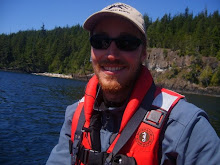 Update: after an overwhelming response from coastal residents and others and discussion with local marine conservation groups, the proponent of the tidal project has withdrawn their application. See this post from the Orca Lab blog for details.
Update: after an overwhelming response from coastal residents and others and discussion with local marine conservation groups, the proponent of the tidal project has withdrawn their application. See this post from the Orca Lab blog for details.I have always been a big fan of tidal power. The BC coast has great potential for all sorts of 'alternative' power with its high winds relentless waves, and all of those narrow passages that can provide over 12 knots of current twice daily (as was the case in Seymour Narrows the last couple of days). Even when the winds are calm and the waves low, the tidal exchange still reliably generates substantial quantities of energy with relatively little impact.
So if someone told me that there was going to be a tidal generator development in my neck of the woods, I'd be all over it right? Well as it turns out, there is a feasibility study for tidal energy being conducted right now, less than twenty miles from where I'm sitting. The only problem is that the location is in of the worst possible from a marine conservation standpoint.
Location of the proposed tidal power project site in Blackney Pass, B.C.
Site 1 on the chart above is more commonly known as Blackney Pass and is one of the most active areas on the coast for a number of different types of whales. In fact, it is in the very heart of the federally designated 'Critical Habitat' for the threatened northern resident killer whales, and has more recently been a very active area for the recovering local population of humpback whales.
Proposed tidal power site overlaid on northern killer whale critical habitat
The internationally renowned Orca Lab, based on Hanson Island, is directly to the west of the project site. The site represents the center of their study area as Blackfish Sound, and Blackney Pass in particular, are areas where these whales can be reliably seen foraging all summer long. For a more thorough description of why this area is so important to the whales please read this excellent post by the Marine Detective.
The problem is that these whales are over-encumber by a plethora of threats (to which they owe their endangered status), ranging from shortage of prey (salmon) to chemical contaminants that come with the dubious honor of being a top predator. A US government workshop on the environmental effects of tidal energy development, conducted in 2010, identified a range of potential effects that projects like this could have on marine mammals and other large mobile sea creatures. When added to the numerous threats facing the whales, these effects could have a very large cumulative impact – the sum of all the effects of all the pressures on these creatures.
To the marine conservation and research community and the many other environmental stewards in the area, such a proposal in the heart of whale activity is a slap in the face to all they have worked for.
Proper planning is needed if the critical habitat for whales is going to be considered in the sighting criteria for the tidal power producers. Our dependency on fossil fuels as a source of energy, has led to some pretty horrendous environmental problems, not least of all for the ocean and those (such as killer whales) who inhabit it. If sited and operated properly, tidal power can provide a clean and reliable alternative, which reduces our dependence on fossil fuels and our production of atmospheric CO2 that is threatening our oceans. This is a classic conflict between two groups of people who use the ocean for different purposes. It is also very unfortunate because the groups in this conflict have a great deal in common.
Living Oceans has been involved in ocean planning for several years, representing conservation interests and engaging with other sectors and groups to come up with a comprehensive plan for human uses of the ocean environment. Specifically, a plan that looks at all of the areas important to each group, including marine life, and identifies areas where there might be conflict. This provides certainty for industries that need to know where they can operate, creates recommendations that guide management actions and identifies areas of high ecological importance and historical features to ensure they are safeguarded.
That's the goal anyway, and with examples like this, the need for such a plan is clear.
At a high strategic level, the federally led Pacific North Coast Integrated Management Area (PNCIMA) initiative provides us with part of this plan, though its scope was significantly reduced after industry lobbying last year. The recent Marine Planning Partnership between the provincial government and local First Nations is looking at our use of the marine environment at a finer scale with spatial recommendations that will help alleviate the uncertainty about conflicts between users and their impacts on the local wildlife. Hopefully, through processes such as these, we will in future be able to prevent conflicts like the one between tidal energy and whales, before they arise.



No comments:
Post a Comment